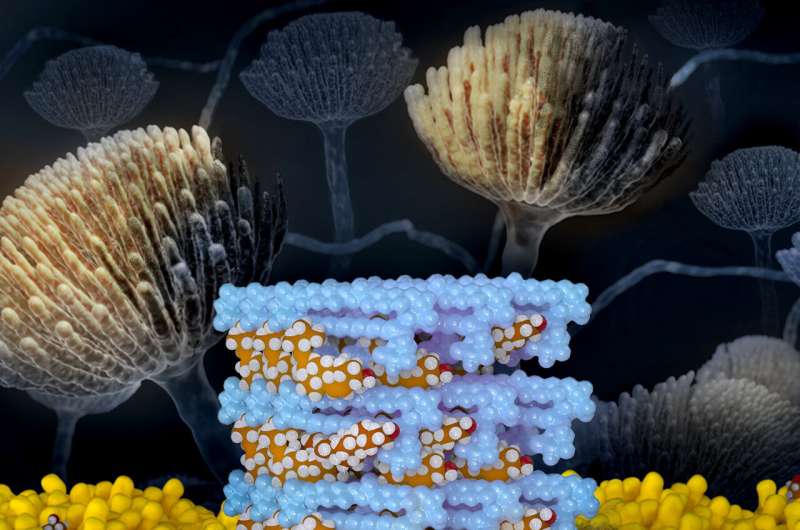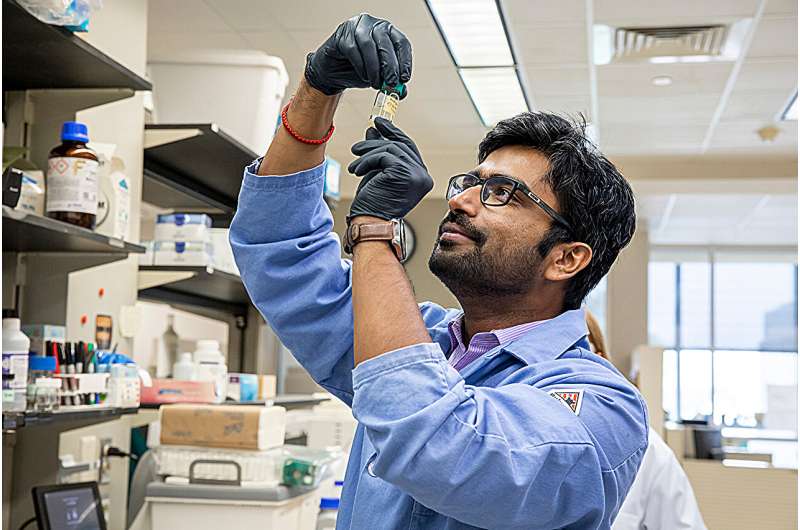This article has been reviewed according to Science X's editorial process and policies. Editors have highlighted the following attributes while ensuring the content's credibility:
fact-checked
peer-reviewed publication
trusted source
proofread
New antifungal molecule kills fungi without toxicity in human cells, mice

A new antifungal molecule, devised by tweaking the structure of prominent antifungal drug Amphotericin B, has the potential to harness the drug's power against fungal infections while doing away with its toxicity, researchers at the University of Illinois Urbana-Champaign and collaborators at the University of Wisconsin-Madison report in the journal Nature.
Amphotericin B, a naturally occurring small molecule produced by bacteria, is a drug used as a last resort to treat fungal infections. While AmB excels at killing fungi, it is reserved as a last line of defense because it also is toxic to the human patient—particularly the kidneys.
"Fungal infections are a public health crisis that is only getting worse. And they have the potential, unfortunately, of breaking out and having an exponential impact, kind of like COVID-19 did. So let's take one of the powerful tools that nature developed to combat fungi and turn it into a powerful ally," said research leader Dr. Martin D. Burke, an Illinois professor of chemistry, a professor in the Carle Illinois College of Medicine and also a medical doctor.
"This work is a demonstration that, by going deep into the fundamental science, you can take a billion-year head start from nature and turn it into something that hopefully is going to have a big impact on human health," Burke said.
Burke's group has spent years exploring AmB in hopes of making a derivative that can kill fungi without harm to humans.
In previous studies, they developed and leveraged a building block-based approach to molecular synthesis and teamed up with a group specializing in molecular imaging tools called solid-state nuclear magnetic resonance, led by professor Chad Rienstra at the University of Wisconsin-Madison. Together, the teams uncovered the mechanism of the drug: AmB kills fungi by acting like a sponge to extract ergosterol from fungal cells.
In the new work, Burke's group worked again with Rienstra's group to find that AmB similarly kills human kidney cells by extracting cholesterol, the most common sterol in people. The researchers also resolved the atomic-level structure of AmB sponges when bound to both ergosterol and to cholesterol.
"The atomic resolution models were really the key to zoom in and identify these very subtle differences in binding interactions between AmB and each of these sterols," said Illinois graduate student Corinne Soutar, a co-first author of the paper.
"Using this structural information along with functional and computational studies, we achieved a significant breakthrough in understanding how AmB functions as a potent fungicidal drug," Rienstra said. "This provided the insights to modify AmB and tune its binding properties, reducing its interaction with cholesterol and thereby reducing the toxicity."
Armed with the information from the NMR studies, the Illinois team began synthesizing and testing derivatives with slight changes to the region that binds to ergosterol and cholesterol, while also boosting the kinetics of the ergosterol-removing process to maintain efficacy.
Enabled by collaborators and facilities at the Carl R. Woese Institute of Genomic Biology and U. of I. veterinary clinical medicine professor Dr. Timothy Fan, the researchers tested the most promising derivatives—first with in vitro assays, quickly assessing the efficacy in killing fungi; then moving to cell cultures and eventually live mice, assessing toxicity.

One molecule, dubbed AM-2-19, stood out from the rest.
"This molecule is kidney-sparing, it is resistance evasive and it has broad spectrum efficacy," said postdoctoral researcher Arun Maji, a co-first author of the paper. "We tested this molecule against over 500 different clinically relevant pathogen species in four different locations. And this molecule completely surprised us by either mimicking or surpassing the efficacy of current clinically available antifungal drugs."
The researchers tested AM-2-19 in human blood and kidney cells to screen for toxicity. They also tested AM-2-19 in mouse models of three common, stubborn fungal infections and saw high efficacy.
"During my medical rotations, we called AmB 'ampho-terrible,' because of how hard it was on patients," Burke said. "Decoupling the efficacy from the toxicity turns 'ampho-terrible' into 'ampho-terrific.' We are very excited about the potential we are seeing, although clinical study is needed to see if this potential translates to people."
As a first step toward clinical application, AM-2-19 has been licensed to Sfunga Therapeutics and recently entered Phase 1 clinical trials.
More information: Martin Burke, Tuning sterol extraction kinetics yields a renal-sparing polyene antifungal, Nature (2023). DOI: 10.1038/s41586-023-06710-4. www.nature.com/articles/s41586-023-06710-4
Journal information: Nature
Provided by University of Illinois at Urbana-Champaign




















